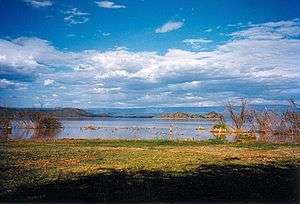Lake Baringo
| Lake Baringo | |
|---|---|
 | |
| Coordinates | 0°38′N 36°05′E / 0.633°N 36.083°ECoordinates: 0°38′N 36°05′E / 0.633°N 36.083°E |
| Primary inflows | El Molo, Ol Arabel |
| Basin countries | Kenya |
| Surface area | 130 km2 (50 sq mi) |
| Surface elevation | 1,000 m (3,300 ft) |
| Designated | January 10, 2002[1] |
Lake Baringo is, after Lake Turkana, the most northern of the Kenyan Rift Valley lakes, with a surface area of about 130 square kilometres (50 sq mi) and an elevation of about 970 metres (3,180 ft). The lake is fed by several rivers, Molo, Perkerra and Ol Arabel, and has no obvious outlet; the waters are assumed to seep through lake sediments into the faulted volcanic bedrock. It is one of the two freshwater lakes in the Rift Valley in Kenya, the other being Lake Naivasha.[2] It lies off the beaten track in a hot and dusty setting and over 470 species of birds have been recorded there, occasionally including migrating flamingos. A Goliath heronry is located on a rocky islet in the lake known as Gibraltar.
Description
The lake is part of the East African Rift system. The Tugen Hills, an uplifted fault block of volcanic and metamorphic rocks, lies west of the lake. The Laikipia Escarpment lies to the east.
Water flows into the lake from the Mau Hills and Tugen Hills. It is a critical habitat and refuge for more than 500 species of birds and fauna, some of the migratory waterbird species being significant regionally and globally. The lake also provides an invaluable habitat for seven fresh water fish species. One, Oreochromis niloticus baringoensis (a Nile tilapia subspecies), is endemic to the lake. Lake fishing is important to local social and economic development. Additionally the area is a habitat for many species of animals including the hippopotamus (Hippopotamus amphibius), Nile crocodile (Crocodylus niloticus) and many other mammals, amphibians, reptiles and the invertebrate communities.[2][3]
While stocks of Nile tilapia in the lake are now low, the decline of this species has been mirrored by the success of another, the marbled lungfish (Protopterus aethiopicus) which was introduced to the lake in 1974 and which now provides the majority of fish output from the lake. Water levels have been reduced by droughts and over-irrigation. The lake is commonly turbid with sediment, partly due to intense soil erosion in the catchment, especially on the Loboi Plain south of the lake.
The lake has several small islands, the largest being Ol Kokwe Island. Ol Kokwe, an extinct volcanic centre related to Korosi volcano north of the lake, has several hot springs and fumaroles, some of which have precipitated sulfur deposits. A group of hot springs discharge along the shoreline at Soro near the northeastern corner of the island.
Several important archaeological and palaeontological sites, some of which have yielded fossil hominoids and hominins, are present in the Miocene to Pleistocene sedimentary sequences of the Tugen Hills.[4][5][6]
The main town near the lake is Marigat, while smaller settlements include Kampi ya Samaki and Loruk. The area is increasingly visited by tourists and is situated at the southern end of a region of Kenya inhabited largely by pastoralist ethnic groups including Il Chamus, Rendille, Turkana and Kalenjin. Accommodation (hotels, self-catering cottages and camping sites) as well as boating services are available at and near Kampi-Ya-Samaki on the western shore, as well as on several of the islands in the lake.[7]
The journey to Lake Baringo was famously noted to be "... a genuine pain in the ass" by Jimmy Stewart in a poem read on the Tonight Show with Johnny Carson.[8]
See also
- Rift Valley lakes
- Korosi, a volcano at the northern end of Lake Nakuru
Sister projects
 Media related to Lake Baringo at Wikimedia Commons
Media related to Lake Baringo at Wikimedia Commons Chisholm, Hugh, ed. (1911). "Baringo". Encyclopædia Britannica (11th ed.). Cambridge University Press.
Chisholm, Hugh, ed. (1911). "Baringo". Encyclopædia Britannica (11th ed.). Cambridge University Press.
References
- ↑ "Ramsar List". Ramsar.org. Retrieved 13 April 2013.
- 1 2 See "Kenya designates freshwater lake in Great Rift Valley," at Ramsar 2009 - 2002.
- ↑ "Kenya Birds - baringo". www.kenyabirds.org.uk. Retrieved 2008-03-17.
- ↑ e.g. Ward, Steven; Hill, Andrew (1987), "Pliocene Hominid Partial Mandible from Tabarin, Baringo, Kenya", American Journal of Physical Anthropology, 72 (1): 21–37, doi:10.1002/ajpa.1330720104 Cite uses deprecated parameter
|coauthor=(help) Abstract from web search - ↑ Tugen Hills examples from Smithsonian website, Smithsonian National Museum of Natural History, retrieved 1 May 2010
- ↑ Wood, Bernard (1999), "Plio-Pleistocene hominins from the Baringo Region, Kenya", in Andrws, P., & Banham, P. (editors), Late Cenozoic Environments and Hominid Evolution: a Tribute to Bill Bishop, London: Geological Society, pp. 113–122, retrieved 1 May 2010
- ↑ "Lake Baringo". www.lake-baringo.com. Retrieved 2012-02-16.
- ↑ AllJohnnyCarson (2015-07-26), Johnny Carson with Jimmy Stewart, Lake Baringo Poem, retrieved 2016-06-07